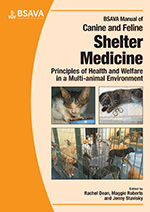
Full text loading...

Skin disease is common in cats and dogs, and can be a reason for relinquishment, abandonment, or even consideration for euthanasia. However, many dermatological conditions are very amenable to diagnosis and effective treatment within the shelter without marked expense. This chapter will describe dermatological problems of particular relevance in the shelter setting. Quick reference guides: Zoonotic diseases in shelters; Dealing with the itchy dog: is it atopic dermatitis?; Exotic diseases in shelters.
Skin diseases in shelter animals, Page 1 of 1
< Previous page | Next page > /docserver/preview/fulltext/10.22233/9781910443330/9781910443330.16-1.gif

Full text loading...

























